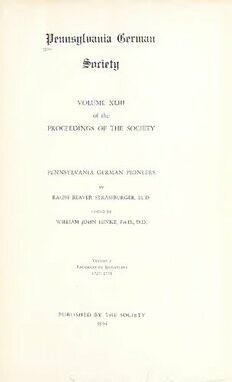
Pennsylvania German Pioneers: A Publication of the Original Lists of Arrivals in the Port of Philadelphia 1727-1806 in three volumes; facsimiles 1727-1775 PDF
Preview Pennsylvania German Pioneers: A Publication of the Original Lists of Arrivals in the Port of Philadelphia 1727-1806 in three volumes; facsimiles 1727-1775
flnutHglitama Gkrmatt i»0rirtu VOLUME XLIII of the PROCEEDINGS OF THE SOCIETY PENNSYLVANIA GERMAN PIONEERS BY RALPH BEAVER STRASSBURGER, LL.D. EDITED BY WILLIAM JOHN HINKE, Ph.D., D.D. Volume 2 Facsimiles of Signatures 1727-1775 PUBLISHED BY THE SOCIETY 1934 5 9? r,'i y 3 a (o .93 v 3 C-. PENNSYLVANIA GERMAN PIONEERS IN THREE VOLUMES Volume II Facsimiles 1727-1775 280191 PENNSYLVANIA GERMAN PIONEERS A Publication of the Original Lists of Arrivals In the Port of Philadelphia From 1727 to 1808 By Ralph Beaver Strassburger, LL.D. ''President ofthe 'Pennsylvania German Society Edited by William John Hinke, Ph.D., D.D IN THREE VOLUMES Volume II Facsimile Signatures 1727 - 1775 PENNSYLVANIA GERMAN SOCIETY NORRISTOWN, PENNSYLVANIA 1934 Copyright, 1934, by PENNSYLVANIA GERMAN SOCIETY MANUFACTURED IN THE UNITED STATES OF AMERICA BY THE VAIL-BALLOU PRESS, INC., BINGHAMTON, N. Y. INTRODUCTION This volume contains the facsimiles of all the signatures to the oath of allegiance (Lists B) as well as those to the oath of abjuration (Lists C). The captains’ lists (Lists A) were not A reproduced, with two exceptions, namely lists 229 and 233 A. In these two cases no other lists were available, and, as it seemed desirable to include at least one list of each ship, these two captains’ lists were inserted. A brief explanation is herewith offered by the editor as to the manner in which the lists were reproduced. There were two methods of reproduction available, either by half tones or by line etchings. After some experimenting the latter method was chosen, as it seemed to offer several advantages. In the first place, it was possible by this method to remove most of the numerous inkspots, which deface so many of the lists. T hen, it enabled the editor to strengthen many thin, hardly discernible lines, which would not have appeared on the half tones at all. And lastly, in the case of many names, which could be read only with great difficulty, with the help of the magnifying glass, the editor was able to trace these names and thus make them stand out from the mass of surrounding inkspots. The latter were then removed by Japanese white. But no names were touched until the whole list had been deciphered and gone over again and again. Many hours of tedious and painstaking work were thus spent in making the lists readable. In this work, the editor had the hearty and efficient co- operation of the Horace McFarland Company, the best J. photographers that could be secured for this work in Harris- burg, Pennsylvania. In some cases as many as three photo- graphs were taken to present the lists in the best possible form. After the photographers had produced the best possible photographs, the editor went over them with minute care, strengthening lines or tracing names, until the result seemed satisfactory. Then, the photographs were placed in the hands of Mr. F. P. Shea, of the Sun Engraving Company of Binghamton, New VI Pennsylvania German Pioneers York, who removed all inkspots with Japanese white and then prepared the line etchings. They are as good as they can pos- sibly be made under the circumstances. Whoever has seen the originals in the State Archives at Harrisburg, will be surprized at the remarkably clear reproductions which are presented in this volume. Some of the B lists were so large, with three columns to a page, that it was found impracticable to reproduce them by one photograph. In such cases, especially in lists 199 B, 203 B, 215 B, 216 B, and 234 B, the third column was reproduced separately. In one case, 222 B, three photos were taken of the first two columns and three of the third column of names. In this case the photographs were made to overlap slightly, so as to indicate the proper sequence of the names. The lists of a number of ships, which arrived on the same day, such as ships Nos. 58 C and 59 C, 69 C and 70 C, 71 C, 72 C, 73 C, 79 C and 80 C, were written on one sheet. In these cases it was occasionally impossible to separate the C lists of the various ships. It was, therefore, necessary to present the B lists in a group, followed by the C lists in a similar group. The editor has added two lists of German characters, as used in the signatures of the lists, capitals as well as small letters. They will serve as a key to the lists and will be found, we hope, a welcome assistance to readers, in helping them to decipher the names for themselves. Finally, to prove the superiority of line etchings, two pages of half tones have been added, pages which are by no means the worst in appearance. They are, we believe, a visible demonstra- tion that line cuts are a superior means of reproducing such lists. William Hinke. J. Auburn Theological Seminary, Auburn, New York.
